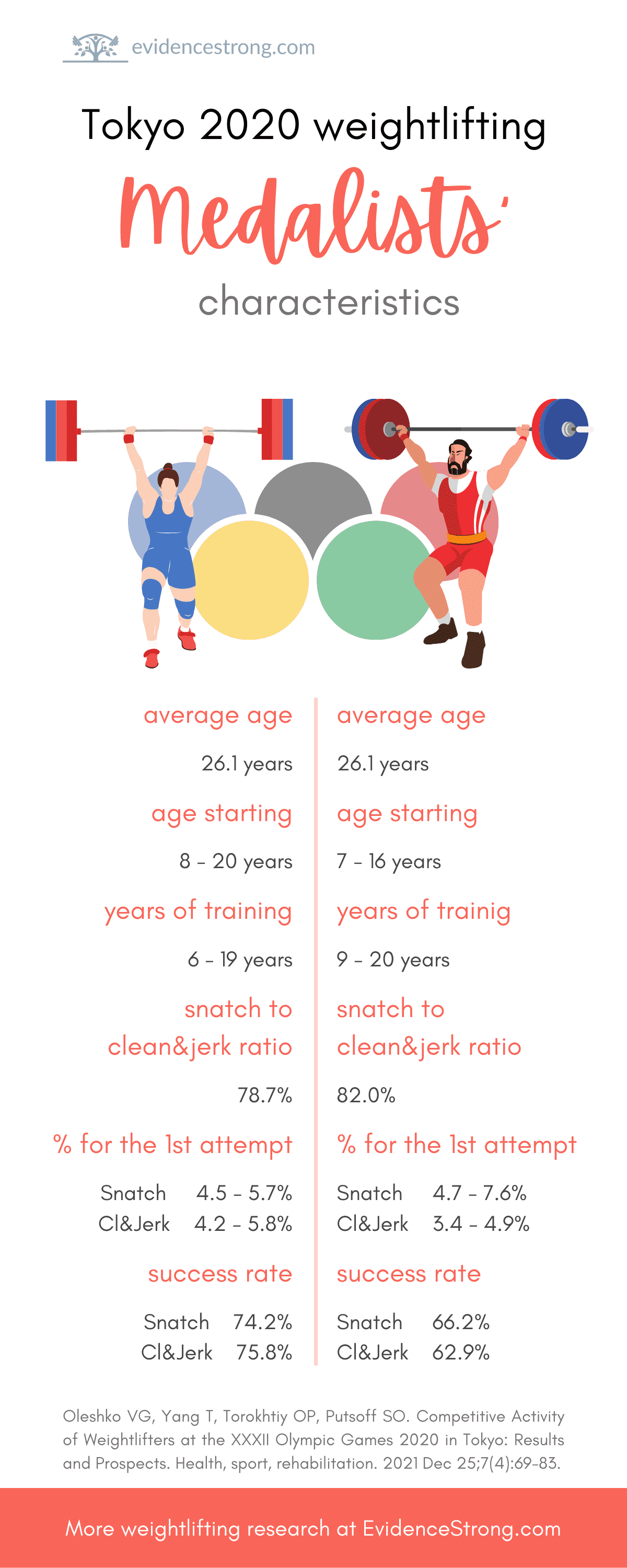Summary of an article analysing characteristics of weightlifting athletes who were successful at the Tokyo 2020 Olympics. categories:
Who
140 athletes who placed 1-10th at the Tokyo 2020 Olympics.
Design
Data analysis of results and characteristics of the weightlifting athletes at the Tokyo 2020 Olympics
Outcome measures
- medals’ count
- medalists’ characteristics
Main results
- 42 medals:
- China 8 (out of 8 athletes that they brought)
- Italy 3
- Indonesia 3
- Ecuador 2
- Taiwan 2
- USA 2
- Dominican Republic 2
- Georgia 2
- Venezuela 2
- Kazakhstan 2
- Philippines 1
- Canada 1
- India 1
- Turkmenistan 1
- United Kingdom 1
- Japan 1
- Mexico 1
- Qatar 1
- Uzbekistan 1
- Columbia 1
- Armenia 1
- Iran 1
- Latvia 1
- Syria 1
medalists’ ages ranged from 19 to 37 years.
Women's weight classes49 kg55 kg59 kg64 kg76 kg87 kg+87 kgAverage age (range)Women's weight classes49 kg23 (19-26)55 kg28 (26-30)59 kg25 (21-28)64 kg29 (24-34)76 kg24 (22-28)87 kg27 (24-29)+87 kg27 (21-33)Men's weight classes61 kg67 kg73 kg81 kg96 kg109 kg+109 kgAverage age (range)Men's weight classes61 kg27 (22-32)67 kg26 (23-28)73 kg28 (25-31)81 kg29 (24-37)96 kg23 (23-25)109 kg25 (21-29)+109 kg25 (22-27)medalists’ age of starting weightlifting: The age of starting ranged from as early as 7 years of age to 20 years of age. In general, men started earlier than women.
Women's weight classes49 kg55 kg59 kg64 kg76 kg87 kg+87 kgAverage age (range)Women's weight classes49 kg12 (9-14)55 kg10 (9-11)59 kg13 (10-16)64 kg14 (8-19)76 kg14 (11-16)87 kg14 (11-16)+87 kg17 (12-20)Men's weight classes61 kg67 kg73 kg81 kg96 kg109 kg+109 kgAverage age (range)Men's weight classes61 kg11 (10-12)67 kg10 (7-14)73 kg11 (10-12)81 kg15 (14-16)96 kg10 (9-11)109 kg10 (9-12)+109 kg11 (10-11)medalists’ years/time to achieve the maximum result: The athletes have spent from 6 to 20 years to get to their best result. Athletes with lower time to achieve their result are considered promising, as they may still improve if they spend more years in the sport.
Women's weight classes49 kg55 kg59 kg64 kg76 kg87 kg+87 kgTime (range)Women's weight classes49 kg11 (10-12)55 kg15 (12-19)59 kg13 (10-18)64 kg14 (8-19)76 kg10 (6-12)87 kg10 (8-14)+87 kg10 (7-10)Men's weight classes61 kg67 kg73 kg81 kg96 kg109 kg+109 kgTime (range)Men's weight classes61 kg13 (11-16)67 kg15 (10-19)73 kg16 (14-20)81 kg11 (9-14)96 kg12 (11-12)109 kg14 (9-20)+109 kg15 (11-17)medalists’ snatch to clean & jerk ratio:
- women on average 78.7 ± 2.7%
- men on average 82.0 ± 2.2%
- women achieve success due to increase in clean & jerk results, while men due to increase in both snatch and clean & jerk.
medalists’ starting weight percentage for snatch:
women on average 4.5 - 5.7% reduction from the maximal (3rd) attempt
men on average 4.7 - 7.6% reduction from the maximal (3rd) attempt
Women's weight classeslight (49, 55, 59 kg)medium (64, 76 kg)heavy (87, +87 kg)Starting weight %Women's weight classeslight (49, 55, 59 kg)95.6 ± 1.7medium (64, 76 kg)96.2 ± 1.8heavy (87, +87 kg)95.1 ± 1.6Men's weight classeslight (61, 67, 73 kg)medium (81, 96 kg)heavy (109, +109 kg)Starting weight %Men's weight classeslight (61, 67, 73 kg)95.3 ± 2.5medium (81, 96 kg)97.4 ± 0.5heavy (109, +109 kg)95.3 ± 1.7
medalists’ starting weight percentage for clean & jerk:
- women on average 4.2 - 5.8% reduction from the maximal (3rd) attempt
- men on average 3.4 - 4.9% reduction from the maximal (3rd) attempt
- medalists’ success rate [%]:
- women average 74.2% in snatch, 75.8% in clean & jerk
- men average 66.2% in snatch, 62.9% in clean & jerk
- women performed more consistently in the clean & jerk, and men in the snatch. In general, women performed more successful lifts than men.
How competitive each weight class was (calculate as a % difference between the 1st and 10th athletes’ results):
the most competitive class was 64 kg. The least competitive were +87 and +109 kg classes.
Women's weight classes49 kg55 kg59 kg64 kg76 kg87 kg+87 kgDifference [%]Women's weight classes49 kg20.555 kg17.059 kg16.164 kg8.176 kg22.887 kg16.7+87 kg31.3Men's weight classes61 kg67 kg73 kg81 kg96 kg109 kg+109 kgDifference [%]Men's weight classes61 kg15.367 kg10.373 kg11.381 kg15.396 kg11.5109 kg13.7+109 kg22.0
There were 25 Olympic records broken by women and 30 Olympic and 4 World records broken by men.
Bonus
Using the data from this study, I have graphed how competitive each weight class was at the Tokyo 2020 Olympics. On the left side, I have added the proposed Paris 2024 weight classes. Please note that this analysis depends solely on the individual results of the athletes who placed 1-10 at the Tokyo 2020 Olympics. It is a very small sample size, influenced by for example which countries got licences (and how many)
Take home message
Original article
Oleshko VG, Yang T, Torokhtiy OP, Putsoff SO. Competitive Activity of Weightlifters at the XXXII Olympic Games 2020 in Tokyo: Results and Prospects. Health, sport, rehabilitation. 2021 Dec 25;7(4):69-83.
You might want to read next
Which weightlifting shoe won the most medals at the Tokyo Olympics?
Medical care at the Tokyo 2020 Olympics’ weightlifting venue

